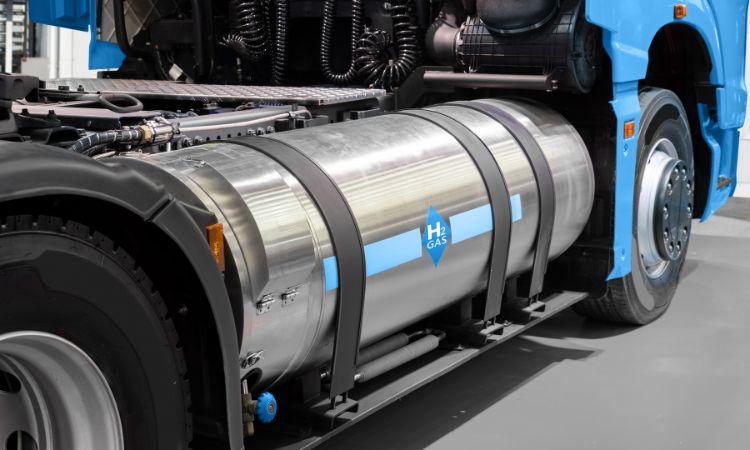The global fuel cell powertrain market size reached approximately USD 0.64 billion in 2023. The market is estimated to grow at a CAGR of 79.7% in the forecast period of 2024-2032, reaching a value of around USD 21.38 billion by 2032. As the world grapples with environmental challenges and the need for sustainable transportation options becomes increasingly apparent, fuel cell powertrains are emerging as a promising solution. In this blog post, we will explore the remarkable environmental benefits of fuel cell powertrains, shedding light on how they contribute to a cleaner and more sustainable future in transportation.
How Fuel Cell Powertrains Work
To understand the environmental advantages of fuel cell powertrains, it’s essential to grasp the fundamentals of how they operate. Unlike traditional internal combustion engines, which rely on the burning of fossil fuels, fuel cell powertrains generate electricity through an electrochemical process. This process involves the use of hydrogen gas and oxygen from the air to produce electricity, with water vapor as the only byproduct. The absence of harmful emissions such as carbon dioxide (CO2) and nitrogen oxides (NOx) is a significant environmental advantage.
Fuel cells consist of various components, including an anode, cathode, and electrolyte. When hydrogen is supplied to the anode and oxygen to the cathode, a chemical reaction occurs in which hydrogen ions (protons) travel through the electrolyte, generating electricity. This clean and efficient conversion of hydrogen into electricity sets fuel cell powertrains apart from conventional engines.
Reduced Greenhouse Gas Emissions
One of the most compelling environmental benefits of fuel cell powertrains is their ability to reduce greenhouse gas emissions significantly. The burning of fossil fuels in internal combustion engines is a major contributor to CO2 emissions, which are a primary driver of climate change. In contrast, fuel cell vehicles produce zero tailpipe emissions.
According to a study by the U.S. Department of Energy, fuel cell vehicles can reduce greenhouse gas emissions by over 50% compared to their gasoline-powered counterparts. This reduction in emissions is due to the use of hydrogen as a fuel source and the absence of combustion-related emissions. As the hydrogen used in fuel cells can be produced from renewable sources, such as wind or solar power, the potential for emissions reduction is even greater.
In addition to CO2, fuel cell vehicles also produce fewer nitrogen oxides (NOx), a group of harmful pollutants that contribute to smog and respiratory problems. The reduction in NOx emissions has a positive impact on air quality, particularly in urban areas where traffic congestion is common.
Air Quality Improvement
The environmental benefits of fuel cell powertrains extend beyond reducing greenhouse gas emissions. They also have a significant impact on improving air quality, which directly benefits public health. Traditional internal combustion engines release not only CO2 and NOx but also particulate matter and volatile organic compounds, all of which can have detrimental effects on air quality and human health.
Fuel cell vehicles, on the other hand, produce only water vapor and a small amount of heat as emissions. This means that they do not contribute to the formation of smog or the release of harmful particles into the atmosphere. As a result, cities that adopt fuel cell vehicles experience cleaner and healthier air, reducing the risk of respiratory diseases and improving overall quality of life for residents.
Energy Efficiency
Another key environmental advantage of fuel cell powertrains is their high energy efficiency. Fuel cells are inherently more efficient at converting fuel into electricity compared to internal combustion engines, which have energy losses associated with combustion and heat dissipation.
Fuel cell vehicles can achieve energy conversion efficiencies of up to 60%, while internal combustion engines typically operate at around 20-30% efficiency. This means that more of the energy from the fuel is used to propel the vehicle, resulting in less wasted energy and reduced fuel consumption.
Furthermore, fuel cell powertrains can incorporate regenerative braking systems, which capture and store energy during deceleration and reuse it to power the vehicle. This regenerative process further enhances energy efficiency, making fuel cell vehicles an attractive option for those seeking sustainable transportation solutions.
Reduction of Noise Pollution
In addition to their environmental and energy efficiency benefits, fuel cell powertrains also contribute to a quieter and more peaceful urban environment. Traditional vehicles with internal combustion engines generate noise through the constant cycle of ignition, combustion, and exhaust.
Fuel cell vehicles, by contrast, operate quietly because they do not rely on combustion. The absence of noisy engine components and the smooth operation of fuel cells make these vehicles ideal for reducing noise pollution in urban areas. This reduction in noise has a positive impact on the well-being of city dwellers and can lead to improved quality of life.
Read More Articles
biggest motorcycle company in the world
Challenges and Considerations
While the environmental benefits of fuel cell powertrains are clear, there are challenges and considerations that must be addressed for widespread adoption. One of the primary challenges is the production and distribution of hydrogen, which is the fuel source for fuel cell vehicles.
Hydrogen can be produced through various methods, including steam methane reforming (SMR) and electrolysis. To maximize the environmental benefits, it is crucial to produce hydrogen using renewable energy sources such as wind, solar, or hydroelectric power. Additionally, the development of a hydrogen infrastructure for distribution and refueling stations is essential to support the growth of fuel cell vehicles.
Another consideration is the sustainability of hydrogen sourcing. It’s imperative to ensure that hydrogen production methods align with environmental goals and do not contribute to carbon emissions or environmental harm.
Conclusion
In conclusion, the global fuel cell powertrain market is poised for remarkable growth, with a projected CAGR of 79.7% from 2024 to 2032, reaching a value of around USD 21.38 billion by 2032. This growth is driven by the compelling environmental benefits of fuel cell powertrains.
These powertrains reduce greenhouse gas emissions, improve air quality, enhance energy efficiency, and reduce noise pollution. As the world seeks sustainable transportation solutions to combat climate change and improve urban living conditions, fuel cell powertrains are emerging as a pivotal technology that can contribute to a cleaner and more sustainable future.
While challenges remain, such as hydrogen production and distribution, ongoing research and development efforts are addressing these issues. With continued investment and innovation, fuel cell powertrains have the potential to play a significant role in achieving a more sustainable and environmentally friendly transportation system. By embracing this technology, we can move closer to a greener and healthier planet for future generations.



